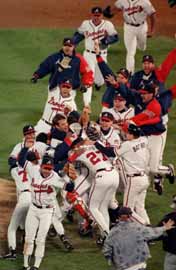 Linda Greenhouse's recent New York Times on the relative scarcity of female Supreme Court clerks, to say the least, has caused quite a stir among lawyers and law professors. The Greenhouse article extends an inquiry begun earlier this summer by Feminist Law Professors, Prettier Than Napoleon, and the Volokh Conspiracy. After the publication of the Greenhouse article, the Georgetown Law Faculty Blog, SCOTUSblog, Sentencing Law and Policy, the Volokh Conspiracy (again), and WSJ Law Blog have all entered the fray. Prettier Than Napoleon helpfully reminds us that Wikipedia's list of Supreme Court clerks should enable a curious empiricist to test the many hypotheses that are now swirling around the issue.
Linda Greenhouse's recent New York Times on the relative scarcity of female Supreme Court clerks, to say the least, has caused quite a stir among lawyers and law professors. The Greenhouse article extends an inquiry begun earlier this summer by Feminist Law Professors, Prettier Than Napoleon, and the Volokh Conspiracy. After the publication of the Greenhouse article, the Georgetown Law Faculty Blog, SCOTUSblog, Sentencing Law and Policy, the Volokh Conspiracy (again), and WSJ Law Blog have all entered the fray. Prettier Than Napoleon helpfully reminds us that Wikipedia's list of Supreme Court clerks should enable a curious empiricist to test the many hypotheses that are now swirling around the issue.True to its mission, MoneyLaw will now make an observation or two -- strictly on the academic worth of the Supreme Court clerkship. The question of balance among men and women in this elite corps will wait.
The Supreme Court clerkship remains the most elite credential available to an American lawyer. Law firms are willing to pay substantial bonuses to associates who bring the experience or perhaps just the cachet to work. But to what extent does a Supreme Court clerkship predict success in legal academia?
 I strongly suspect that the Supreme Court clerkship, in the mind of a MoneyLaw-minded academic talent scout, has become the law school equivalent of the 270-foot dash that Billy Beane won when he entered the baseball draft. The story is vividly recounted in Michael Lewis's Moneyball.
I strongly suspect that the Supreme Court clerkship, in the mind of a MoneyLaw-minded academic talent scout, has become the law school equivalent of the 270-foot dash that Billy Beane won when he entered the baseball draft. The story is vividly recounted in Michael Lewis's Moneyball. The 270-foot dash measures raw speed, specifically over the maximum distance that a baseball player is likely to run on an ordinary play. It's nice to be that fast, and speed over 270 feet translates into more triples and more reliable scoring from first base on doubles hit by a player's teammates. On even rarer occasions, speed over 270 feet means scoring from first off a single (in a play most famously associated with Enos Slaughter). The related skill of covering 360 feet with extreme celerity raises the probability, however slightly, of the inside-the-park home run.
But these baseball plays are spectacular precisely because they are rare. As a result, the 270-foot dash measures something that is probably more salient in the mind of the talent scout than it is relevant to the business of trading runs for outs. Billy Beane finished his major league career with more strikeouts than hits (80 to 66) and a woeful OPS of .546. OPS, by the way, stands for On-base percentage Plus Slugging percentage. Baseball traditionalists will more readily understand Billy Beane's lifetime .219 batting average, dangerously close to the Mendoza line and flatly unacceptable for an outfielder. It was no fluke; Billy took the better part of six seasons to compile this wretched record.
If the foregoing is sabermetric gibberish to you, no amount of linking now will help you. Perhaps I shall explain in a future MoneyLaw post. Suffice it for the moment to observed that Billy Beane, first-round bonus baby, winner of the 270-foot dash at his combine, basically ... pardonnez-moi, je cherche le mot juste en français ... sucked.
This is not to suggest that the Supreme Court clerkship should be devalued altogether as an academic credential. Nor would I conclude that the clerkship hangs like an albatross around the neck of a law professor so unfortunate as to have spent a year of her or (more likely) his life working at 1 First Street N.E., Washington, DC 20543. Like any other factor that correlates only weakly, if at all, with ultimate success, the 270-foot dash, the Supreme Court clerkship, the newly fashionable brand name Pee-Aitch-Dee, and other rough guides to future performance are just that: rough guides. For every Billy Beane, there are other first-round draft picks whose careers have resembed that of B.J. Surhoff (overpaid mediocrity), Chipper Jones (marginal Hall of Fame candidate), or Alex Rodriguez (probable Hall-of-Famer, barring injury). So it is in law and law teaching. Predicting 40 years of productivity on the basis of an individual's appeal to a Supreme Court Justice at the age of 27 or 28 is at best a perilous pursuit.



 Announcing a preference for a region or a state doesn't communicate a comparably negative message. On the contrary, all this says is that a candidate has family responsibilities -- intragenerational, intergenerational, or both.
Announcing a preference for a region or a state doesn't communicate a comparably negative message. On the contrary, all this says is that a candidate has family responsibilities -- intragenerational, intergenerational, or both. Last spring my friend Gordon Hylton put together
Last spring my friend Gordon Hylton put together  Anyone who finds MoneyLaw interesting will also find
Anyone who finds MoneyLaw interesting will also find  Now for a quick glimpse at the flip side of MoneyLaw: what law and allied disciplines have to say about the business of baseball. Mark McDonald and Daniel A. Rascher recently posted
Now for a quick glimpse at the flip side of MoneyLaw: what law and allied disciplines have to say about the business of baseball. Mark McDonald and Daniel A. Rascher recently posted 
 OK, so Christine Hurt, building on Joe Liu's brilliant suggestion for a
OK, so Christine Hurt, building on Joe Liu's brilliant suggestion for a 
 Ilya Somin's post,
Ilya Somin's post,  I thought I'd begin my time here with a simple question: what's the relationship between a law review's quality and the quality of its parent institution? This is an important question for money-law folks, because it raises some possibilities for measuring the quality of law schools. But I arrived at that question because I have been working as faculty advisor to the
I thought I'd begin my time here with a simple question: what's the relationship between a law review's quality and the quality of its parent institution? This is an important question for money-law folks, because it raises some possibilities for measuring the quality of law schools. But I arrived at that question because I have been working as faculty advisor to the 





 With the designation of
With the designation of